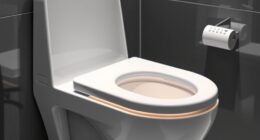Choosing the right BTU for your portable air conditioner is key to cooling efficiently and saving energy. To find the ideal size, measure your room and consider factors like sunlight, insulation, and use. Smaller spaces need around 5,000–6,000 BTUs, while larger rooms require 12,000 BTUs or more. Avoid oversizing or undersizing, as it can waste energy or fail to cool effectively. Keep exploring to get expert tips on selecting the perfect portable AC.
Key Takeaways
- Match the BTU rating to your room size to ensure effective cooling without wasting energy.
- Use the standard BTU guidelines: about 5,000–6,000 for up to 150 sq ft, and higher for larger spaces.
- Consider additional factors like sunlight, insulation, and occupancy that influence BTU needs.
- Avoid choosing a unit with too few or too many BTUs to prevent inefficiency and uneven cooling.
- Properly size your portable AC with room measurements and load calculations for optimal comfort.
Understanding BTU and Its Role in Cooling Efficiency

Understanding BTU is essential to choosing a portable air conditioner that effectively cools your space. BTU, or British Thermal Unit, measures how much heat an AC unit can remove from the air in an hour. The higher the BTU, the more cooling power the unit has. Selecting a unit with too few BTUs means it’ll struggle to cool your room efficiently, while too many BTUs can lead to unnecessary energy use and humidity issues. Knowing how BTU relates to your space helps you find the right balance between cooling capacity and energy consumption. It’s a key factor in ensuring your portable AC keeps your room comfortable without wasting electricity or creating unwanted humidity. Proper understanding of BTU helps you make smarter, more effective cooling choices. Additionally, considering filter features can improve air quality and overall comfort in your space. For optimal performance, it’s also important to understand the impact of cooling efficiency on your energy bills and environmental footprint. Being aware of room size requirements ensures you select an appropriately sized unit for your needs. Recognizing the importance of load calculation can further refine your choice to match your specific cooling needs.
How to Calculate the Right BTU for Your Room Size
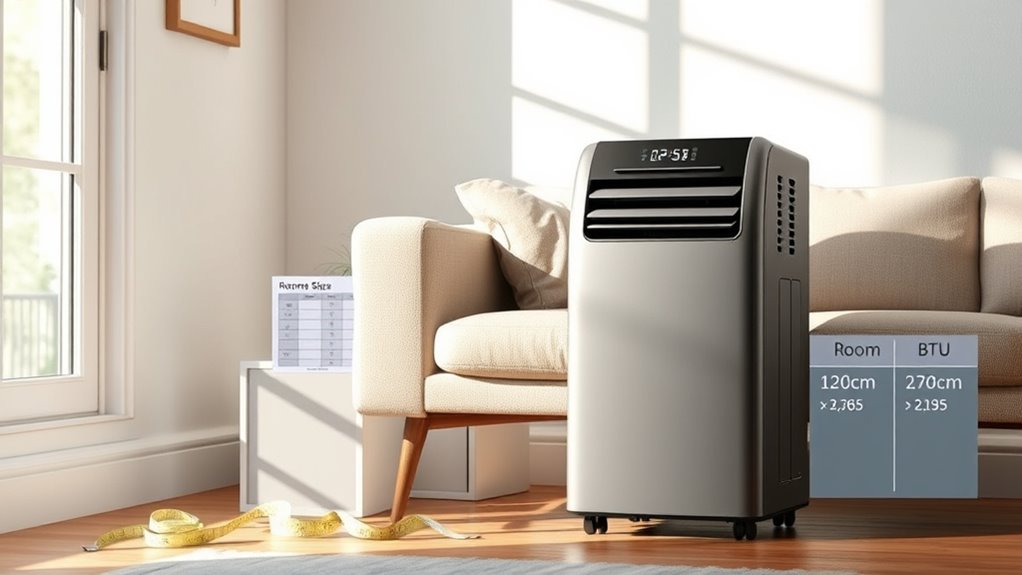
To determine the right BTU for your room, you need to measure the space accurately and consider its specific characteristics. Start by calculating the square footage: multiply the length by the width of your room. For example, a 12×15-foot room totals 180 square feet. Next, factor in your room’s features: higher ceilings, large windows, or sun exposure can increase cooling needs, so add about 10% for these elements. Conversely, if your room is shaded or well-insulated, you might need slightly less BTU. Remember, an underpowered unit won’t cool effectively, while an oversized one can waste energy and cause uneven cooling. Accurate measurements and consideration of room specifics are key to selecting a portable AC that works efficiently. Incorporating proper sizing techniques to stay proactive during the BTU sizing process can also help ensure you make the best choice for your needs. Additionally, understanding how bike components like tires and gears function can improve your overall maintenance and safety. Recognizing the importance of sound therapy in creating a comfortable environment can further enhance your cooling experience.
Common BTU Ranges for Different Room Types
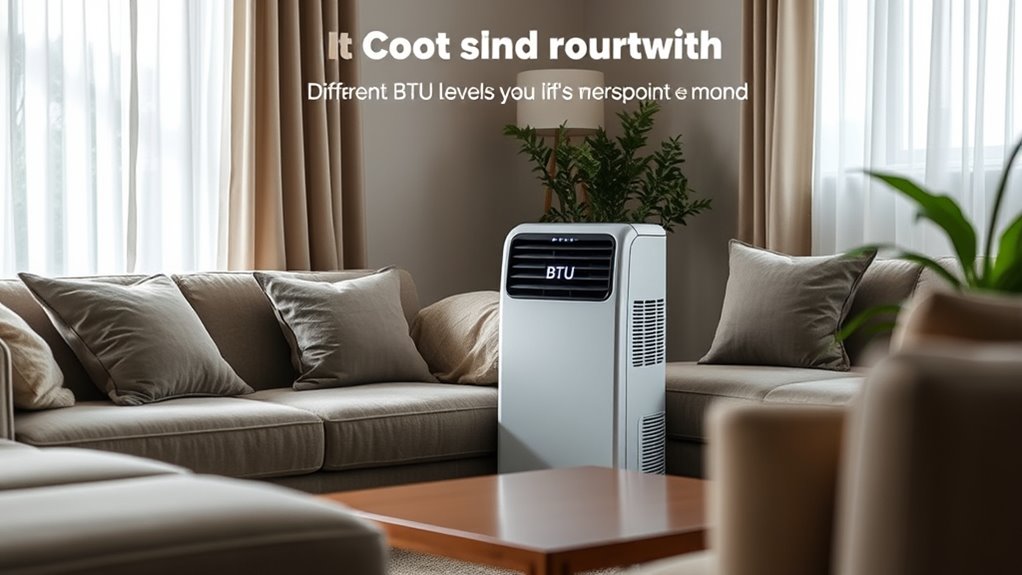
Understanding the BTU range you need depends on your room size. Smaller rooms typically require less cooling power, while larger spaces need higher BTU ratings. Let’s look at the common BTU ranges suited for different room types to help you choose the right portable air conditioner. For optimal performance, selecting a best suited BTU rating ensures efficient cooling and energy savings. Additionally, considering room insulation can impact the effective BTU needed for comfortable cooling.
Small Room BTU Needs
Choosing the right BTU rating for a small room depends on its size and purpose. For spaces up to 150 square feet, a unit with 5,000 to 6,000 BTUs usually works well, providing adequate cooling without wasting energy. If your room measures between 150 and 250 square feet, aim for 6,000 to 8,000 BTUs to ensure comfort. Bedrooms typically require slightly higher BTUs to offset body heat and appliances, often around 5,000 to 8,000 BTUs for small spaces. Keep in mind, factors like sunlight, insulation, and the number of occupants can influence the ideal BTU size. Proper room insulation can significantly impact cooling efficiency and comfort. Additionally, considering climate conditions in your area can help determine the most energy-efficient BTU range. Being aware of energy efficiency standards can also guide your selection to save on operational costs. Understanding airflow requirements ensures your portable air conditioner can adequately circulate conditioned air throughout the space. Incorporating proper sizing techniques reduces the risk of overworking the unit and enhances overall performance. By selecting the appropriate BTU range, you’ll maximize efficiency and comfort, avoiding under- or over-cooling your small room.
Large Space Cooling
Ever wonder how to select the right BTU range for larger rooms? For spaces like living rooms, open-plan areas, or garages, you’ll need a higher BTU capacity to cool effectively. Typically, large rooms require between 12,000 and 18,000 BTUs. If your space is around 300-500 square feet, aim for about 12,000 BTUs. For rooms over 500 square feet, consider units closer to 18,000 BTUs to ensure proper cooling. Keep in mind, factors like ceiling height, insulation, and sunlight exposure can influence your BTU needs. Proper BTU sizing helps you choose an air conditioner that provides optimal comfort while conserving energy. Selecting the right BTU capacity is essential for energy efficiency and effective cooling. Choosing the right size means you’ll cool your space efficiently without wasting energy or forcing your unit to work harder. Proper BTU sizing guarantees comfort and maximum performance for larger areas.
Signs You Might Need a Higher or Lower BTU Unit
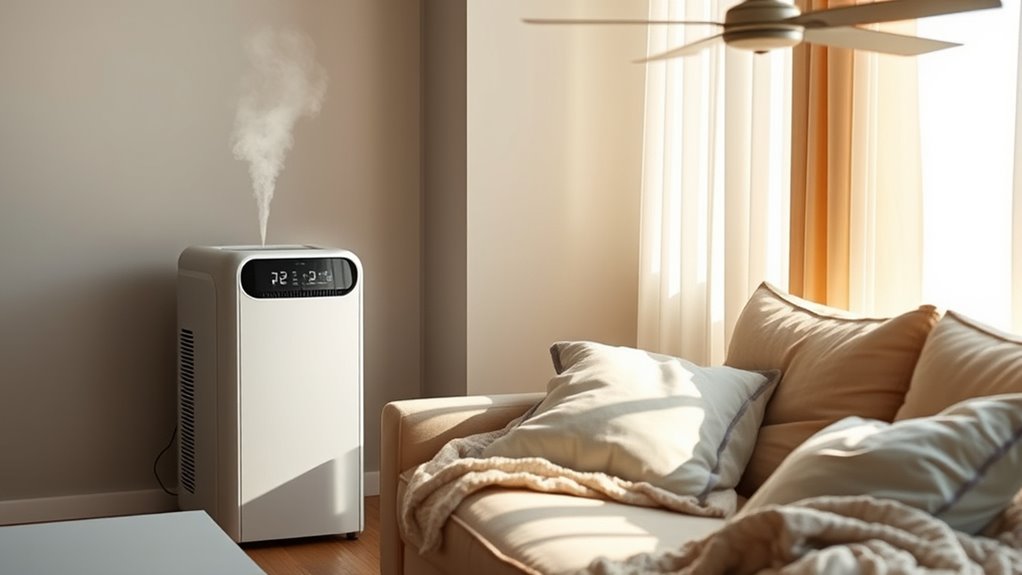
If your portable air conditioner struggles to cool the space effectively or runs constantly without reaching the desired temperature, it might be time to contemplate a unit with a different BTU rating. If it’s constantly running, your current unit may be too small for the room size, forcing it to work nonstop. Conversely, if it cools too quickly and then shuts off, it might have too high a BTU, causing short cycling and inefficient operation. You’ll also notice signs like uneven cooling, persistent humidity, or the unit struggling during peak heat. These clues suggest your current BTU might not match your space’s needs. Adjusting to the right BTU ensures comfort, energy efficiency, and less wear on your AC over time.
Tips for Choosing the Most Effective Portable AC Based on BTU
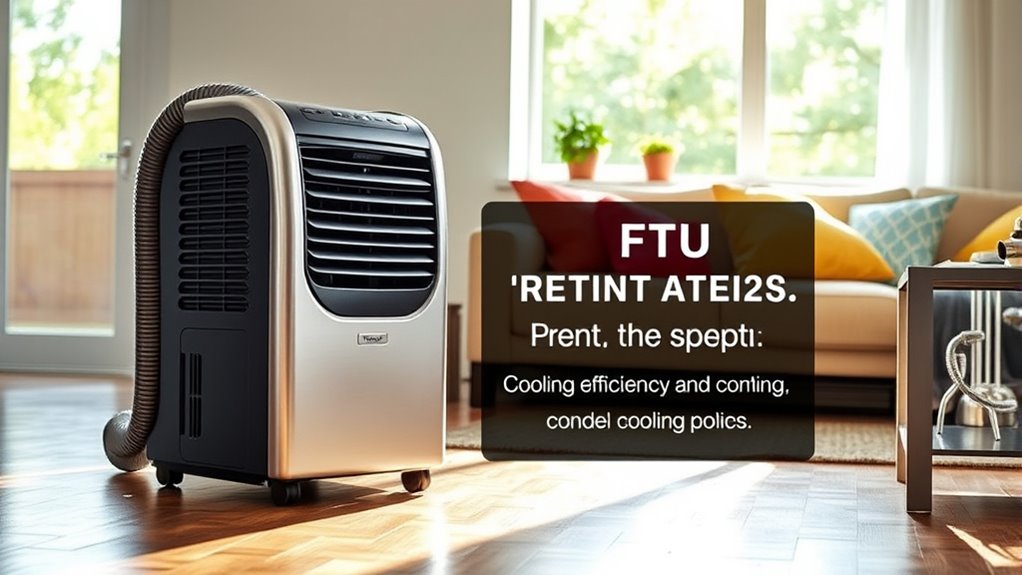
When choosing a portable AC, make sure it matches the size of your room for maximum cooling. Consider energy efficiency to save on power bills while keeping your space comfortable. Paying attention to these factors helps you select the most effective unit for your needs.
Room Size Compatibility
Choosing the right portable air conditioner depends heavily on matching its BTU rating to your room size. If you select one with too few BTUs, it’ll struggle to cool the space effectively, leading to longer run times and higher energy bills. Conversely, an oversized unit can cool the room too quickly, resulting in inefficient humidity removal and uneven temperature distribution. Measure your room’s square footage accurately, including ceiling height if possible. For smaller rooms (up to 150 square feet), a unit with around 5,000 BTUs works well. Medium-sized spaces (150-300 square feet) typically need 8,000 to 10,000 BTUs. Larger rooms require even higher BTU ratings. Properly matching BTUs to your room size guarantees effective cooling, energy efficiency, and comfort.
Energy Efficiency Considerations
Matching your portable air conditioner’s BTU rating to your room size not only guarantees effective cooling but also impacts energy consumption. An oversized unit will cycle on and off frequently, wasting energy and increasing wear. Conversely, a unit that’s too small will struggle to cool the space, causing it to run constantly and use more power. To maximize efficiency, choose a BTU rating that aligns with your room’s size and insulation quality. Look for models with energy-saving features like programmable timers, Eco modes, and adjustable fan speeds. Proper maintenance—such as regular filter cleaning—also assures the unit operates at peak efficiency. By selecting the right BTU and leveraging energy-efficient features, you’ll keep your cooling effective while minimizing your electricity bill.
Mistakes to Avoid When Selecting Your Portable Air Conditioner

Selecting the wrong portable air conditioner can lead to ineffective cooling and wasted money. One common mistake is choosing a unit that’s too small for your space, which won’t cool efficiently and will run constantly. Conversely, selecting an overly large unit can cause short cycling, increasing energy costs and reducing lifespan. Another error is ignoring the BTU rating and room size; always match your AC’s capacity to your space’s square footage. Additionally, neglecting features like proper ventilation or exhaust setup can hinder performance. Don’t overlook noise levels if your space requires quiet operation. Finally, avoid focusing solely on price—cheaper units may lack essential features or durability. Making well-informed choices based on your room size and needs ensures better cooling and long-term savings.
Frequently Asked Questions
How Does Room Insulation Affect BTU Requirements?
Room insulation plays a key role in determining how much cooling power you need. If your room is well-insulated, it retains cool air better, so you might need a lower BTU unit. Poor insulation allows heat to seep in, making your space warmer and requiring a higher BTU air conditioner to keep it comfortable. Proper insulation helps your AC work efficiently and saves energy by reducing the cooling load.
Can Multiple Small Units Outperform a Single High-Btu AC?
Did you know that multiple small air conditioners can sometimes outperform a single high-BTU unit? If you have a large or oddly shaped space, spreading out cooling with several units can target hot spots more effectively. This approach offers flexibility, easier maintenance, and often better temperature control. So, if you’re trying to cool diverse areas, multiple smaller units might be your best bet for comfort and efficiency.
Does Ceiling Height Influence BTU Calculations?
Ceiling height definitely influences BTU calculations because taller ceilings mean more air volume to cool. When your ceilings are higher than standard (8 feet), you’ll need a higher BTU rating to effectively cool the space. Ignoring this can leave your room warmer than desired, as the air volume increases. Always adjust your BTU needs based on ceiling height to make sure your portable AC cools efficiently and comfortably.
How Do Additional Heat Sources Impact BTU Needs?
Imagine your room is a battlefield, and heat sources are relentless invaders. When you add extra heat sources—like appliances, sunlight, or lighting—they turn up the temperature’s intensity. You need a more powerful air conditioner to tame this fiery chaos. So, don’t forget to account for these heat invaders; otherwise, your cool haven might turn into a sweltering battleground, leaving you longing for real relief.
Is BTU Rating the Only Factor to Consider?
You might think BTU rating is the only thing to consider, but it’s not. While BTU measures cooling power, other factors matter too. Think about room size, insulation, window exposure, and your climate. These influence how well your portable AC performs. A higher BTU isn’t always better if other conditions aren’t ideal. So, evaluate all these factors to make sure you pick the right portable air conditioner for your space.
Conclusion
By mastering the measurement of BTU and matching it to your room’s size, you’ll make a smart, satisfying, and notably cooler choice. Remember to take into account your space’s specific needs, avoid the pitfalls of over- or under-sizing, and select a portable air conditioner that perfectly fits your lifestyle. With careful calculation and confident decision-making, you’ll conquer the climate chaos and create a cool, comfortable haven you can truly cherish.








